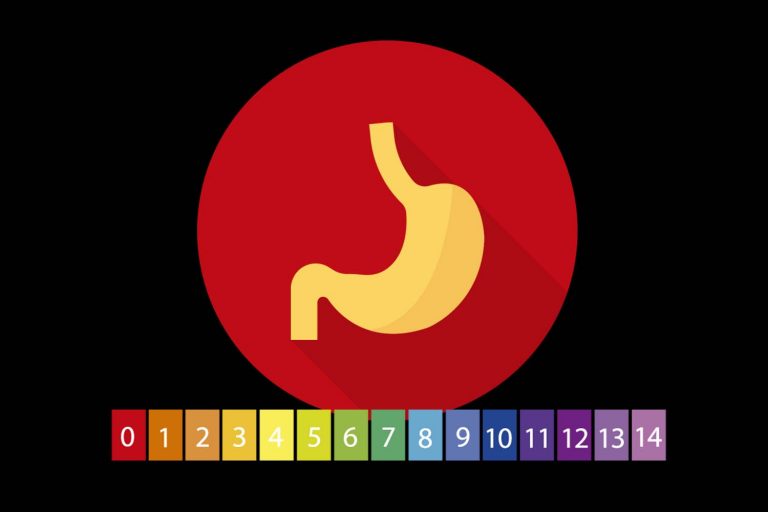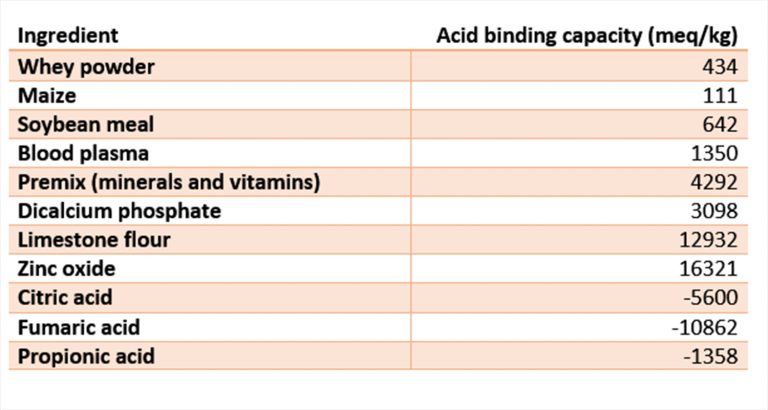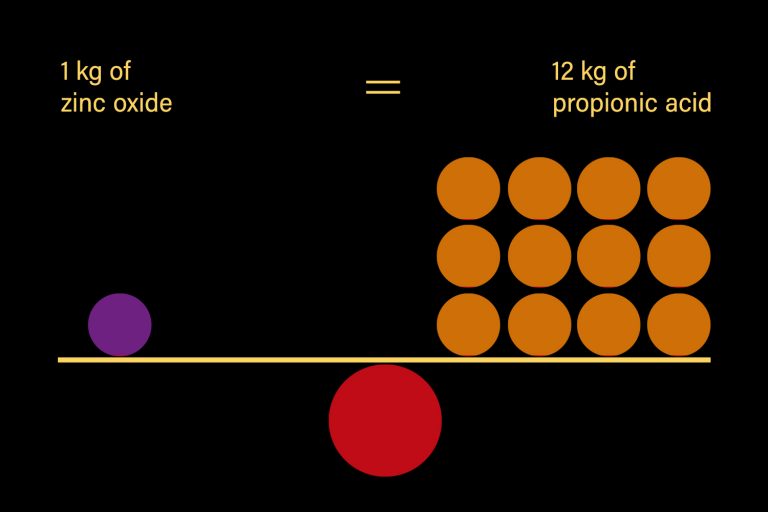09 Nov Understanding the importance of acid-binding capacity in piglet feeds

In the pig, protein digestion starts in the stomach and finishes in the duodenum. There are three main enzymes involved: pepsin (secreted by the stomach), trypsin and chymotrypsin (both secreted by the pancreas).
Pepsin is secreted as its inactive precursor, called pepsinogen. The transformation of pepsinogen into pepsin occurs rapidly at pH 2.0 but slows down dramatically at pH 5.0. Furthermore, pepsin is only active at a pH between 2.0 and 3.5.

In adult pigs, the pH of the stomach is 2.5-4.0, but in piglets the pH is 4.5-7.0 due to a poor production of gastric acid.
As a result of a high pH in piglet’s stomach,
- Proteins cannot be digested properly.
- Undigested proteins arrive to the intestine and become substrate for the growth of pathogenic bacteria.
- A higher stomach pH allows pathogens coming from feed and from the environment to survive and colonize the digestive tract, starting digestive infections.
Therefore, in order to maintain gut health in piglets it is necessary to keep the pH in the stomach below 4.0. The administration of acidifiers is the most common practice, but to be effective it must be combined with the design of diets with low acid-binding capacity.
What is acid-binding capacity?
The acid binding capacity (also called buffering capacity) is defined as the resistance of a feedstuff to the pH reduction by gastric acid. Chemically, it is described as the amount of hydrochloric acid in milliequivalents (meq) required to lower the pH of 1 kg of feedstuff to pH 4.0.
The acid binding capacity (also called buffering capacity) is defined as the resistance of a feedstuff to the pH reduction by gastric acid. Chemically, it is described as the amount of hydrochloric acid in milliequivalents (meq) required to lower the pH of 1 kg of feedstuff to pH 4.0.
Inside piglet’s stomach, a feed with a high acid binding capacity absorbs a large amount of gastric acid and makes it difficult for the stomach’s pH to reach 4.0 or less. As the digestive system of the piglet is immature and secretion of acid is low, a feed with high acid binding capacity impairs the digestibility of proteins and leads to diarrhea and poor growth.
It is recommended that feeds for young piglets have a buffer capacity not higher than 650 meq/Kg.
Acid binding capacity of some feedstuffs used in pig feeds

Zinc oxide counteracts the effect of acidifiers
Zinc oxide has a very high acid binding capacity, more than 16000 meq/Kg. On the other hand, the organic acids that are used as acidifiers in piglet feeds have a negative acid binding capacity because they act by lowering the pH of the stomach. From these values, it can be deducted that it takes 1.6 kg of fumaric acid or 12 kg of propionic acid to neutralize the strong acid binding capacity of 1 kg of zinc oxide.
In the practice, especially outside Europe where the use of zinc oxide is limited, many piglet feeds contain 2-3 kg/ton of zinc oxide together with 1-3 kg/ton of organic acids. From the calculations made above, we can conclude that zinc oxide is raising the total acid binding capacity of the diet, impairing protein digestion, and most importantly that it is counteracting the effect of acidifiers. In a diet containing 2-3 kg/ton of zinc oxide plus 1-3 kg/ton of organic acids, the organic acids cannot be effective and only add cost to the formula, without any result in vivo.

Replacing zinc oxide totally or partially with natural growth promoters is an excellent solution to achieve a feed formulation with an adequate acid binding capacity, to promote the effectiveness of acidifiers and to prevent digestive problems in young piglets.
PigletPlus© is a mixture of plant extracts, organic acids and mycotoxin binders designed as a complete solution to gut health problems in piglets. It has been proven to successfully replace antibiotic growth promoters and zinc oxide.
Thanks to our laboratory services, we can help our customers to determine the acid binding capacity of their feeds, optimizing feed formulation.
Do not miss any of our articles!
Subscribe to our monthly newsletter

Certain health statements may not be applicable in your region.

